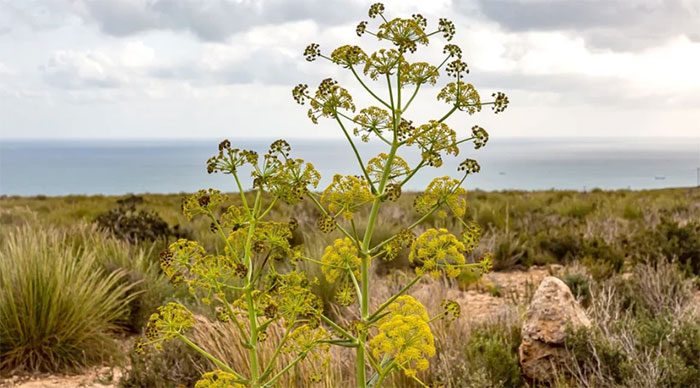Asafoetida is one of the most commonly used spices in Indian cuisine, although its aroma can be shocking to those encountering it for the first time.
A “Smelly” Spice
Asafoetida (originally known as A ngùy) is a wild plant native to Afghanistan, Iran, and Uzbekistan.
The resin from the roots of this plant is used as a cooking spice in India – typically, the root is ground into a powder and mixed with flour. While it is often said that asafoetida has a terrible smell, that may not be entirely accurate. In fact, its odor is so pungent that it has become one of the most divisive spices in India.
In Persian, “Asa” means candy, while in Latin, “foetida” means rotten. However, in India, this spice is referred to as “hing”. It also has a slang name, “devil’s dung”, for reasons that are quite clear. If someone accidentally gets a bit of asafoetida on their hands, the foul smell lingers for a long time, no matter how many times they wash. Placing a small pinch of asafoetida in the mouth can result in a burning sensation.

The smell of asafoetida even overpowers the scent of all other spices. (Source: CNN).
At the Khari Baoli market in Old Delhi, the smell of asafoetida even overwhelms all other spices. However, it is widely used in Indian cuisine. Despite its unpleasant odor, after cooking, asafoetida takes on a flavor similar to onion and has a relatively pleasant taste.
“Asafoetida can be seen as a spice cluster among the basic flavors of Indian cuisine,” said chefs Siddharth Talwar and Rhea Rosalind Ramji, co-founders of Showbiz Culinary School in India, in an interview with CNN.
According to them, asafoetida “fills the flavor gap” left by onions and garlic, which are banned for religious reasons in large vegetarian communities in India, such as Jainism, Marwaris, and Gujaratis. They noted that despite the diversity of Indian cuisine, asafoetida remains a constant factor.
Ramji acknowledged that the smell of asafoetida can be a challenge for many people: fresh asafoetida has a scent reminiscent of rotten cabbage, which is the reason behind its nickname “devil’s dung.” Therefore, using this spice requires skill and caution. According to Talwar, only a very small amount of asafoetida cooked with hot oil is enough to enhance the dish’s flavor without letting the foul smell dominate.
CNN reported that most Indians buy asafoetida in powdered form to mix with rice or flour. However, adventurous chefs may purchase solid crystal asafoetida, resembling rock salt, and use it in their dishes as they see fit.
The Unique History of Asafoetida
Some scholars suggest that Alexander the Great was the first to introduce asafoetida to India. “The popular theory is that Alexander the Great’s army encountered this plant in the Hindu Kush mountains and mistook it for the rare ‘miracle’ silphium,” explained food historian Dr. Ashish Chopra to CNN.
Silphium was a spice used by ancient peoples both as an aphrodisiac and for contraceptive purposes, as well as for treating various ailments.
“Those under Alexander the Great carefully brought the plant to India, only to later discover it was not what they had thought. But the Indians had their own experiences with asafoetida,” Chopra said.
He added that asafoetida was used in some dishes during ancient Greco-Roman times but did not persist for long. Today, it is rarely found in Western cuisine, with one notable exception: it is used as an ingredient in Worcestershire sauce.
In the context of rapidly changing global culinary trends, some chefs are looking to modify their recipes by omitting onions and garlic in favor of asafoetida. According to Talwar, asafoetida “can enhance flavors that are strong but not overly sweet, salty, sour, or bitter,” which are essential in stews and braised dishes.
Talwar noted that this concept of strong flavor was developed by Japanese culinary experts and is now considered the fifth basic taste in cuisine, following sweet, salty, sour, and bitter.
CNN reported that the American company Burlap & Barrel even sells a spice blend of asafoetida under the brand Wild Hing for those sensitive (allergic) to onions and garlic or on special diets. However, flavor is not the only reason asafoetida is beginning to appear more frequently in spice markets worldwide.
According to the National Library of Medicine, asafoetida has been used as an expectorant, antispasmodic, and for killing parasites or worms. Some people even use it as a remedy for bloating.
And not everyone uses asafoetida for cooking. People in Africa and Jamaica sometimes wear amulets made from asafoetida because they believe it can ward off evil spirits. This plant is also used as a pesticide in organic farming.
What is most surprising is that while India consumes the most asafoetida in the world, this spice has never been cultivated in India until recently. Three years ago, some Indian farmers living in the cold regions of the Himalayas began experimenting with growing asafoetida.
Biologically, asafoetida is a slow-growing plant. However, if Indian farmers can grow asafoetida themselves, they could save the country about 100 million USD annually from importing this ingredient. More importantly, Indians could have a beloved flavor produced entirely domestically.


















































